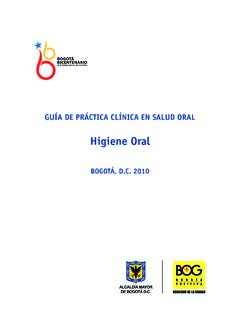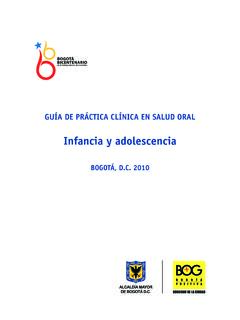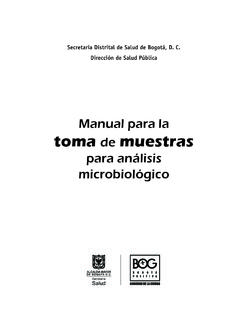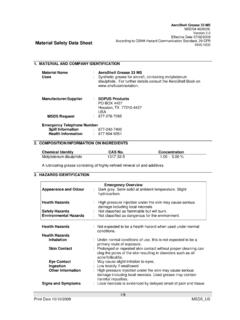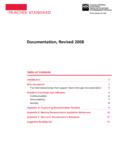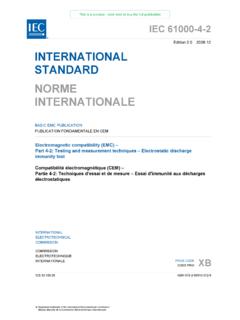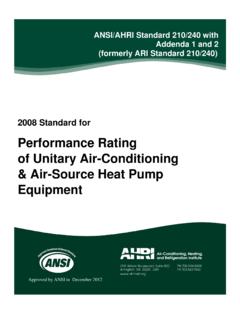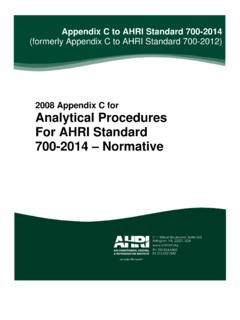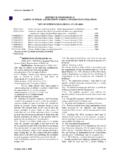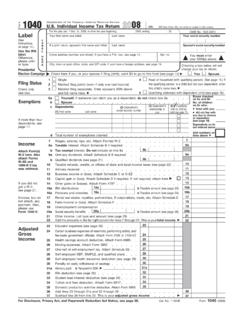Transcription of ANSI/ASHRAE/ASHE Standard 170-2008 s s ES
1 ANSI/ASHRAE/ASHE Standard 170-2008 s s ES Ventilation of Health Care Facilities Approved by the ASHRAE standards Committee on June 21, 2008 ; by the ASH RAE Board of Directors on June 25, 2008 ; by the American Society for Healthcare Engineering of the American Hospital Association on July 18, 2008 ; and by the American National standards Institute on July 24, 2008 . This Standard is under continuous maintenance by a Standing Standard Project Committee (SSPC) for which the standards Committee has established a documented program for regular publication of addenda or revi-sions, including procedures for timely, documented, consensus action on requests for change to any part of the Standard . The change submittal form, instructions, and deadlines may be obtained in electronic form from the ASH RAE Web site, , or in paper form from the Manager of standards .
2 The latest edi-tion of an ASHRAE Standard may be purchased from ASHRAE Customer Service, 1791 Tullie Circle, NE, Atlanta, GA 30329-2305. E-mail: Fax: 404-321-5478. Telephone: 404-636-8400 (world-wide), or toll free 1-800-527-4723 (for orders in US and Canada). Copyright 2008 ASH RAE American Society of Heating, Refrigerating and Air-Conditioning Engineers, Inc. 1791 Tullie Circle NE, Atlanta, GA 30329 ISSN 1041-2336 American Society for Healtltcare Engineering of the American Ho.,}lital A.~<odatlon ASHRAE Standing Standard Project Committee 170 Cognizant TC: TC , Healthcare Facilities SPLS Liaison: H. Michael Newman Richard D. Hermans, Chair* Paul T. Ninomura, Vice-Chair* Michael F. Mamayek, Secretary* Theodore Cohen* George A. Freeman Gerald L. Hendrickson Michael R. Keen* William M. Kingrey Marvin L. Kloostra* Frederick H. Kohloss Peter Hogan Langowski* Anand K.
3 Seth* Rajendra N. Shah* Dennis E. Shaughnessy Michael Patrick Sheerin* Robert J. Weber Michael E. Woolsey* Xudong Yang Michael Mayo *Denotes members of voting status when the document was approved for publication Stephen D. Kennedy, Chair Hugh F. Crowther, Vice-Chair Robert G. Baker Michael F. Beda Donald L. Brandt Steven T. Bushby Paul W. Cabot ASHRAE standards COMMITTEE 2007- 2008 Nadar R. Jayaraman Byron W. Jones Jay A. Kohler James D. Lutz Carol E. Marriott R. Michael Martin Merle F. McBride Kenneth W. Cooper Frank Myers Samuel D. Cummings, Jr. H. Michael Newman K. William Dean Lawrence J. Schoen Robert G. Doerr Bodh R. Subherwal Roger L. Hedrick Jerry W. White, Jr. Eli P. Howard, Ill Bjarne W. Olesen, BOD ExO Frank E. Jakob Lynn G. Bellanger, CO Claire B. Ramspeck, Assistant Director of Technology for standards and Special Projects SPECIAL NOTE This American National Standard (ANS) is a national voluntary consensus Standard developed under the auspices of the American Society of Heating, Refrigerating and Air-Conditioning Engineers (ASHRAE).
4 Consensus is defined by the American National standards Institute (ANSI), of which ASHRAE is a member and which has approved this Standard as an ANS, as "substantial agreement reached by directly and materially affected interest categories. This signifies the concurrence of more than a simple majority, but not necessarily unanimity. Consensus requires that all views and objections be considered, and that an effort be made toward their resolution:' Compliance with this Standard is voluntary until and unless a legal jurisdiction makes compliance mandatory through legislation. ASH RAE obtains consensus through participation of its national and international members, associated societies, and public review. ASH RAE standards are prepared by a Project Committee appointed specifically for the purpose of writing the Standard . The Project Committee Chair and Vice-Chair must be members of ASH RAE; while other committee members may or may not be ASHRAE members, all must be technically qualified in the subject area of the Standard .
5 Every effort is made to balance the concerned interests on all Project Committees. The Assistant Director of Technology for standards and Special Projects of ASH RAE should be contacted for: a. interpretation of the contents of this Standard , b. participation in the next review of the Standard , c. offering constructive criticism for improving the Standard , or d. permission to reprint portions of the Standard . DISCLAIMER ASH RAE uses its best efforts to promulgate standards and Guidelines for the benefit of the public in light of available information and accepted industry practices. However, ASH RAE does not guarantee, certify, or assure the safety or perlormance of any products, components, or systems tested, installed, or operated in accordance with ASHRAE's standards or Guidelines or that any tests conducted under its standards or Guidelines will be nonhazardous or free from risk.
6 ASHRAE INDUSTRIAL ADVERTISING POLICY ON standards ASH RAE standards and Guidelines are established to assist industry and the public by offering a uniform method of testing for rating purposes, by suggesting safe practices in designing and installing equipment, by providing proper definitions of this equipment, and by providing other information that may serve to guide the industry. The creation of ASH RAE standards and Guidelines is determined by the need for them, and conformance to them is completely voluntary. In referring to this Standard or Guideline and in marking of equipment and in advertising, no claim shall be made, either stated or implied, that the product has been approved by ASH RAE. SECTION CONTENTS ANSI/ASHRAEIASHE Standard 170-2008 Ventilation of Health Care Facilities PAGE Foreword .. 2 1 Purpose .. 2 2 Scope .. 2 3 Definitions.
7 2 . 4 Compliance .. 3 5 Planning .. 4 6 Systems and Equipment.. 4 7 Space Ventilation .. 6 8 Planning, Construction, and System Start Up .. 11 9 Normative References .. 12 Informative Annex A .. 12 Informative Annex B: Bibliography .. 13 NOTE When addenda, interpretations, or errata to this Standard have been approved, they can be downloaded free of charge from the ASH RAE Web site at Copyright 2008 American Society of Heating, Refrigerating and Air-Conditioning Engineers, Inc. 1791 Tullie Circle NE Atlanta, GA 30329 All rights reserved. (This foreword is not part of this Standard . It is merely informative and does not contain requirements necessary for conformance to the Standard . It has not been processed according to the ANSI requirements for a Standard and may contain material that has not been subject to public review or a consensus process.)
8 Unresolved objectors on informative material are not offered the right to appeal at ASHRAE or ANSI.) FOREWORD ANSVASHRAEIASHE Standard 170, Ventilation of Health Care Facilities, is one of a family of documents that offers guidance, regulation, and mandates to designers of health care facilities. It is first and foremost a mandatory min-imum requirement and, as such, may not offer the state-of-the-art best practice of health care ventilation design. Other publi-cations, such as the ASHRAE HVAC Design Manual for Hos-pitals and Clinics, may provide more depth and detail for the designer. In addition, the health care designer must refer to any design requirements from the appropriate jurisdiction that has authority. Many jurisdictions use or refer to Guidelines for Design and Construction of Hospitals and Health Care Facilities, published by the American Institute of Architects (AlA).
9 Where practical, the committee was cognizant of these other documents in the development of this Standard . Ventilation design for health care spaces is a combination of tasks that leads to a set of documents used in construction. One such task requires medical planners to develop depart-mental programs of spaces. These programs include space names that suggest the use for which the space is intended, and health care ventilation designers depend upon these names to determine the ventilation parameters for their designs. This Standard provides these ventilation parameters. Without high-quality ventilation in health care facilities, patients, health care workers, and visitors can become infected through normal respiration of particles in the air. Poorly ventilated health care facilities are places where the likelihood of pathogenic particles occurring in the air is quite high.
10 These air-transmitted pathogens can be found every-where in poorly ventilated health care facilities, and although most individuals can cope using their healthy immune sys-tems, some patients are susceptible to these pathogens or even to normal environmental air-borne organisms such as fungal spores. Because these organisms are found in higher concen-trations in hospitals, additional care must be taken in design of the ventilation systems. 1. PURPOSE The purpose of this Standard is to define ventilation system design requirements that provide environmental control for comfort, asepsis, and odor in health care facilities. 2. SCOPE The requirements in this Standard apply to patient care areas and related support areas within health care facilities, including hospitals, nursing facilities, and outpatient facilities. 2 This Standard applies to new buildings, additions to existing buildings, and those alterations to existing buildings that are identified within this Standard .
